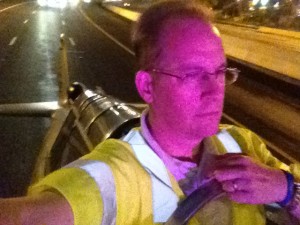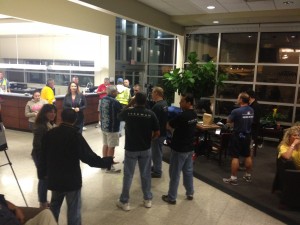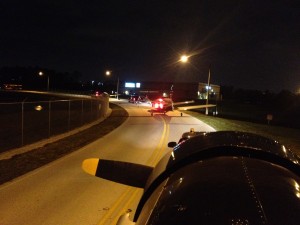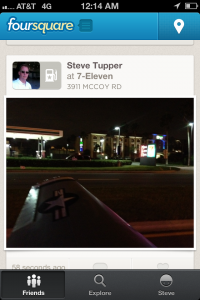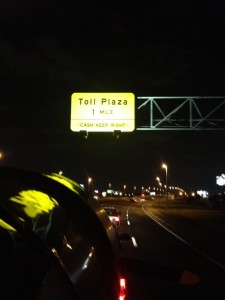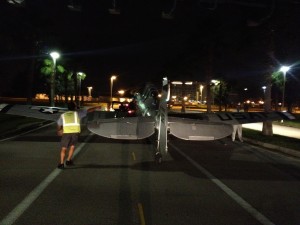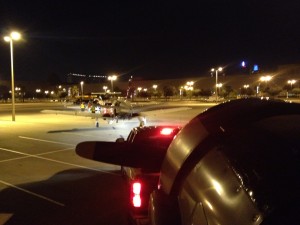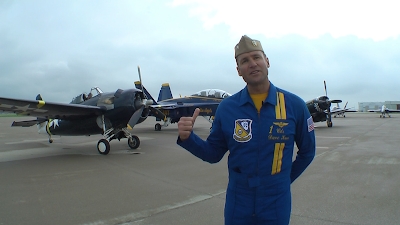These are the show notes to an audio episode. You can listen to the show audio by clicking here: http://traffic.libsyn.com/airspeed/AirspeedT6NBAA.mp3. Better yet, subscribe to Airspeed through iTunes or your other favorite podcatcher. It’s all free!
This has been the year of getting deep behind the scenes at airshows. And I mean deep. How deep will be the subject of an upcoming series.
But, in addition to getting further involved in airshows themselves, I’ve found myself behind the scenes and seeing how things operate in related fields.
Have you ever been to an aviation industry event where there’s a static display of aircraft and you realize that you’re miles away from any airport? These aren’t gliders or other aircraft that are designed to come apart and be towed around on trailers. They’re warbirds or twins, or aerobatic birds. How the heck did they get there?
On a recent Friday night, I found out.
The National Business Aviation Association (or “NBAA”) held its convention at the Orange County Convention Center in Orlando, Florida this year. Several weeks before the convention, I got the call from the airshow coordinator at the Tuskegee Airmen National Historical Museum in Detroit. NBAA is saluting the Tuskegee Airmen and wanted to have the museum’s Tuskegee-flown T-6 on static display at the convention. As the some-time team lawyer, I helped put together the contract.
By pure coincidence, my law firm held its annual partner meeting in Orlando the weekend before the beginning of NBAA. Our airshow coordinator figured that out on Thursday and asked whether I might be interested in playing hooky from the partner meeting for a special assignment.
The NBAA convention was at the Orange County Convention Center. The Convention center is about 11 miles from Orlando International Airport (KMCO). That meant that the T-6 and the eight other static aircraft needed to get from the airport to the convention center by means of the tollway and various surface streets. NBAA and Signature Flight Support had arranged trucks and tow bars to tow the aircraft to the convention center and back. My mission, should I choose to accept it, was to ride in the cockpit of the T-6, be ready on the brakes if the tow bar gave way, jump out and walk wings if needed, and assist in such other ways as I could be helpful.
Hmmmmmm. Ride in a T-6 down the 528 Toll Road in the middle of the night with eight other aircraft. Let me think about that.
I took a cab to Signature and arrived around 9:00 pm local. We briefed around 10:00. The plan, for those following along at home, was to set up on the ramp at Signature with seven aircraft and taxi north on Taxiway A in single file. Pick up two additional aircraft in the conga line at Galaxy. At Juliet, turn out and proceed north on Runway 36L to the gate at the end of the displaced threshold. We couldn’t be on the roads before midnight, so the idea was to be at the gate at 11:50.
At the stroke of midnight, we’d taxi through the gate and make a left onto Bear Road. Turn right and go north on Tradeport Drive and get on the 528 Toll Road at Exit 9. 8.3 miles on 528 to Exit 1. Then International Drive to the main entrance. Squeeze through the 44-foot gap between the poles of the gateway, head out across the grass by the heliport, and finally end up on the parking lot of the convention center.
We arranged the aircraft in roughly ascending order of wingspan, with the idea being that if there was an unforeseen pinch point along the route, all aircraft that were narrower than the pinch point could make it through and continue on to the convention center and only the wider ones would be affected. Our conga line therefore consisted of, in order:
Aviat Husky, Stearman, Cirrus SR22, Eclipse 550, TBM 850, Our T-6, Piper Seneca, Piper Malibu Mirage, Piper Malibu Meridian, and Quest Kodiak.
All but the Husky were towed nose-forward. The Husky was towed tail-first.
Each aircraft had a person sitting at the controls. For the Husky, this added much-needed weight, which was especially important given that the winds were 20G28. And, in all cases, it’s a good idea to have someone in the aircraft to be able to hit the brakes or otherwise react if a tow bar comes loose or something else untoward occurs.
I’ve never flown the T-6. In fact, I’m not even very familiar with its systems. I harbored a momentary fear that I’d get to the airport as the Tuskegee guy and impress everyone by not being able to find the cockpit latch. I needn’t have worried. But I did call up Brian Smith, the usual T-6 pilot, to ask a few questions. I was pretty sure that we were going to horse the aircraft around a little and I wanted to make sure that I understood when and under what circumstances the tailwheel is supposed to break out and caster. I also got a cockpit brief about whether there was anything that I wasn’t supposed to touch or things that I should, in fact, touch.
Around 10:30, I went out to the aircraft, opened up the cockpit, and got her ready to taxi. Signature had already borrowed a tow bar from Stallion 51 up the road, and the aircraft was already hooked up to the truck that would pull her. I checked the hitch and the attach points and mate sure that the controls were locked and that the tailwheel would caster.
I met the driver and we stood around and talked with the Husky guys and the others who were waiting to go. Each driver had a handheld radio. Most of the guys in the aircraft didn’t have radios, so we exchanged mobile phone numbers in case we needed to talk to each other.
Around 11:30, we saddled up and started to taxi. It was windy, but not rainy or especially cold, so I left the cockpit open. We were in the middle of the procession and I could see the headlights and the blinking yellow flashers ahead and behind. Toward the end of Taxiway A, we angled out onto Runway 36L and proceeded all the way out onto the displaced threshold of 18R, which goes all the way to the fence. As we rolled out onto the runway, I was pleased to note that I automatically checked final. The oblique view from the taxiway make it appear that we were rolling out onto the active runway, but it became clear as we got onto the runway proper that the landing traffic was for the parallel. I didn’t have an aviation radio with me, but I thought that it would have been cool to listen in.
We reached the gate on schedule, 10 minutes before midnight. We dismounted and drivers and pilots stood talking quietly under a dark and windy sky. We could see red and blue flashing lights of the police cars staged along the early part of our route. The lead vehicle and a couple of police cars were pulled up at the gate. Several sets of lighted marshaling wands floated into existence. From three or four places around me, I heard radios all squawking the same disjointed noises. Drivers ahead and behind began walking to their vehicles. I walked around behind the wing of the T-6, climbed up, and nestled myself into the cockpit.
The gates drew back and we started forward. The tailwheel went a little sideways in the gravel between the end of the runway pavement and the roadway, but then we were back on the pavement, making a left turn and following in sequence. Snaking around Bear Road, I noticed that several stop signs and other signs near the road were laying flat, either uprooted or cut, to allow wings to pass. Out onto the main road, then under the bridge and toward the on-ramp.
There’s a 7-11 right there and I fired up Foursquare and checked in, including a picture of the 7-11 sign and the T-6’s left wing in the foreground. Best. Foursquare. Check-in. Ever.
Up the on-ramp, and onto the 528 tollway proper. The police had closed the approximately eight miles of the tollway that we needed to use. Once on the tollway, I spent the first mile or so watching the wingtips to make sure that we had adequate clearance. My driver had angled his rear-view mirrors outward to watch the wingtips and I occasionally stood up in my seat to check as well. Convinced that we had adequate clearance for the foreseeable part of the journay, I sat back and relaxed.
It was a nice opportunity to just relax and take in the coolness of what we were doing. The winds had died down a little, but were still moving pretty briskly and a low scattered layer shuttled rapidly across the nearly-full moon. At about 10 mph, the T-6 rolled along steadily and it was surprisingly peaceful. If you must be out on the 528 in the wee hours of the morning, I highly recommend doing it in a T-6 with the canopy open and someone else doing the driving.
I took advantage of some of the weirder moments, too. I couldn’t help but snap a picture of the sign that warned of toll booths ahead. Crap! Where’s the ashtray in the T-6? I’m going to need some change soon.
Soon enough, though, it became apparent that the T-6 has an STC for the SunPass and we went uneventfully through the SunPass lanes. Or at least I don’t think that the camera system caught my tail number.
After about an hour, we came to Exit 1 and took the off-ramp. The procession slowed down substantially. The roadway side markers are about three feet high. They’re plastic and they lay down if pushed. But the plastic is fairly heavy-duty and it’s squared off at the top, making fairly sharp corners. Not something you’d want to drag over the bottom of the T-6’s wing and its rag ailerons. We were going slowly enough that I could dismount and run around behind the tail and the right wing and hold the markers down as the wing passed over each one of them. That lasted for maybe a tenth of a mile, and then it was back into the cockpit for the tow over the surface streets to the convention center gate.
Traffic was light, but there were maybe two dozen vehicles stopped by the police at each intersection. Some people were taking pictures with their smart phones. Some were just glaring. For some, I suppose that we were a welcome diversion. For others, we were a great excuse for breaking curfew. I’m guessing that the one guy who was laying on his horn was in a rush coming back from sneaking out to a poker game or something.
The only real issue came when we got to the main gate of the convention center. I don’t know what the spacing of the two poles at the entrance was, other than to say that it was about two feet more than the wingspan of the T-6. By this time, I was out the aircraft and walking the wingtips. The aircraft right before us had had a tight fit as well, and I ran ahead to get that one through the gap. I therefore had a pretty good idea of the pinch points.
We angled the nose of the T-6 a little and got one wing past the post. Then it became apparent that we were going to have some trouble getting the other wing past. With the nosewheel aircraft, they could simply disconnect the tow bar and work the aircraft back and forth to get the other wing past.
But the T-6 is different. The tailwheel is further from the mains than the nosewheel is from the mains of the nosewheel aircraft. Also, the tailwheel doesn’t always swing gracefully. It’ll take a certain amount of yaw movement, and then it breaks out abruptly before swiveling further sideways. That means that, if the tailwheel starts out in the center and you get some yaw going, you could quickly find yourself with a rapid bit of additional yaw (read: wingtip movement) that you hadn’t counted on. This is important when the wingtip is only a foot or so from a pole.
The NBAA guys had a set of swivel dollies that you can slip under the wheels and jack up the aircraft a few inches so you can move the aircraft sideways or any other direction you like. But it turns out that the T-6’s main wheels were too big to accommodate the swivel dollies. So it was up to a group of maybe six guys, all milling about and getting ready to move the aircraft.
You’ve heard the expression that the amount of intelligence in a group remains the same; only the number of people changes? That tends to be the case whenever you have more than two or three people horsing around an airplane. But the NBAA and Signature guys seemed to understand that and they went slowly. I mean very slowly. One wingtip beyond the pole on its side and the other behind the pole on its side.
A little forward. A little yaw. A little backward. A little more yaw. A little forward. You get the idea. Your mother parallel parking. If your mother was a 4,500-lb T-6.
Eventually, we got the other wingtip past the pole. I was really impressed by the fact that the guy handling the forward wing (the critical wing, because it was the pivot point) had his hand and forearm along the trailing edge of the wing, between the wing and the pole. He was willing to protect the aircraft from the pole with his own forearm. I don’t know that the wing would necessarily have traveled quickly enough to actually injure him, even if the tailwheel broke out at exactly the wrong moment. But the fact of the matter is that he stick his arm in harm’s way to protect the airplane. That rates respect from me.
After a brief taxi across the pavement, we headed off onto the grass near the helipad and then over to the parking lot. The crew had sheets of plywood to help those aircraft with wide stances get a wheel over the curb. The T-6 took that part without even blinking.
We pulled into the parking lot near the marshaling point and static display area. We waited there for a long time while they worked the Kodiak through the gate. That aircraft had perhaps the longest wingspan of the caravan and the tundra tires on that aircraft meant that the dollies wouldn’t work on it. It took them an hour or so to work the Kodiak through the gate but, at last, all nine aircraft stood in the parking lot in the night, ready for placement in the static display area.
The NBAA static director pointed each aircraft to its spot. We pulled the T-6 into a place of honor and the crew disconnected the tow bar while I closed up the aircraft, secured the canvas canopy cover and checked the chocks.
The trip back to the airport took a mere 15 minutes. Everyone was still in high spirits, even though it was 3:30 am. I called a cab and made it back to the hotel by 4:30 am.
The alarm seemed to go off moments after I laid down, but I managed to make it to my 8:00 am meeting and give my part of a presentation without slurring my words or drooling on anything. The partner meeting activities ended around noon and we had the afternoon off for leisure, which I spent getting the other half of Friday night’s sleep. Later that night, we had the banquet at Epcot. I hit the sack again after that and managed to sleep another seven hours before getting up the next morning and doing a side trip with the aviation transactions practice group to tour the Vehicle Assembly Building at Kennedy Space Center and get up close and personal with the Atlantis orbiter before catching a commercial flight back to Detroit.
That Friday night was pretty well indicative of the way my life goes these days. I practice law with a wonderful group of professional people. I’ve been named to Best Lawyers in America five times and I have a national reputation in my practice area. In that respect, I’m not much different from many of my colleagues. Nearly all of them are brilliant in their fields.
If you’re like me, you kind of floated through high school and college without having to work that hard and you were one of the smartest people in the room. Even grad school wasn’t that tasking. Then came law school. Sitting in a room in which most of my classmates were smarter than I was on paper and I was betting 40,000 1995 dollars that I could beat nine out of 10 of them to make law review and get in to interview with the big firms. I realized over the course of law school and then eight years as an associate that there comes a time – long after you can barely remember being the smartest guy in the room – that you’re quite pleased to be in the room in the first place. I spend a lot of time in a pretty rarefied room.
But, even so, I sidestepped out of that world to do something that even those captains of a learned profession wouldn’t dream of doing. While they presided over hotel lounges or slept with CNN casting pale illumination on the walls, I plied the streets though the windy night in the embrace of a ghost from another era. A whole cadre of skilled volunteer stewards of history in Detroit trusted me to shepherd this irreplaceable treasure to its place where the public could again see it and think about what it meant. A team of experienced aircraft handlers wordlessly took me in as an equal and trusted me to walk the wings of the other aircraft when needed and took direction from me as we worked the T-6 through the narrow points.
Then I slipped back into the hotel in the wee hours of the morning with my hair disheveled, grease on my hands, and smelling of that esoteric mix of catcher’s-mitt and ass that marks those who have recently occupied the cockpits of warbirds.
My law colleagues are pretty great people. But most wouldn’t understand. My pilot buddies and airshow bros understand this stuff in their bones.
Guys, we do a pretty special thing. Don’t ever forget that. It didn’t necessarily require a caravan of airplanes in the night to make me think these thoughts. But it sure as hell didn’t hurt, either.
Lastly, a footnote for those who have spent non-trivial time with the Intrepid Fellowship of the Three-Stone Pants. Provided only that a displaced threshold counts, Orlando International Airport belongs to me. I leave the details to the rules committee.
